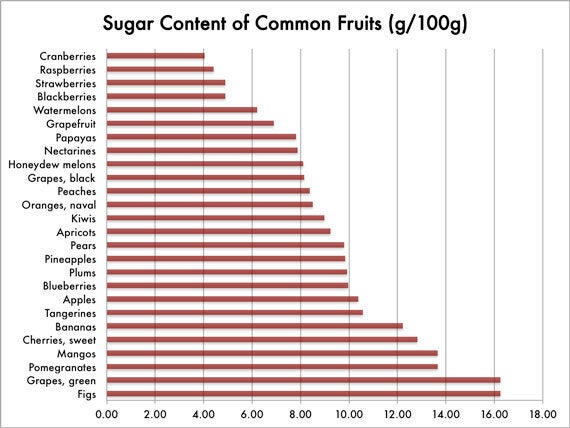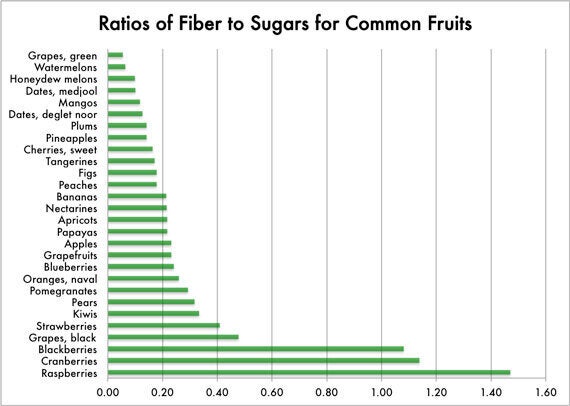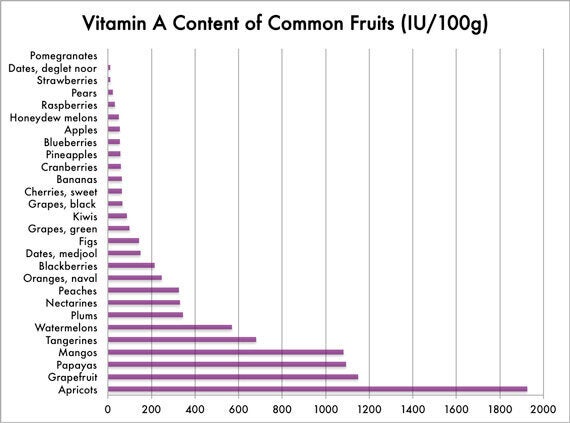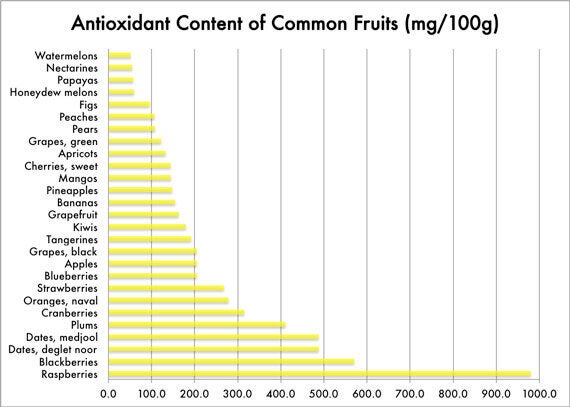I know what you're thinking—not another best/worst fruit article rehashing the same old factoids. Don't worry. This article is different because it provides comparative information. In other words, it's great to know that oranges have plenty of vitamin C, but wouldn't it be more helpful to know how much they have compared to other fruits?
This is a job for a nutrition nerd. You might not know it, but there's a subculture of people who regularly scour the USDA's National Nutrient Database searching seemingly trivial information, like how many grams of polyunsaturated fat walnuts have and what proportion of that fat is linoleic acid. I am one of these people (and I realize I may have issues).
Recently I decided to investigate fruit. Everyone knows fruit is healthy, but surely not all fruit is created equal. From a nutritional perspective, when deciding which fruits to eat, we should favor those with more of the good stuff and less of the questionable stuff. The good stuff is vitamins, antioxidants, and phytonutrients. The questionable stuff is sugar.
The harmful effects of excessive sugar consumption are becoming increasingly apparent, as is the importance of dramatically reducing our intake. In March, for example, the WHO introduced a draft measure to slash sugar consumption recommendations from 10 to 5 percent of total calories. And last month, a study published in the American Journal of Clinical Nutrition found that children consuming higher amounts of sugar have increased cardiovascular disease risk factors. Plenty of research supports decreased sugar consumption, but what about fruit?
Sucrose (common table sugar) is 50 percent glucose and 50 percent fructose. Fruit contains sucrose, glucose, and fructose, but eating whole fruit is different from consuming these molecules as soda or even as fruit juice. Fruit contains fiber, which slows down sugar absorption, thus mitigating its harmful effects. Nevertheless, too much sugar from fiber-intact fruit can also cause problems. Just ask Ashton Kucher.
In analyzing fruits, higher marks should go to those with relatively more fiber and less sugar. There's also evidence that fructose might cause problems not associated with glucose. Virtually every cell in the body uses glucose for energy. The liver, however, bears most of the burden of fructose metabolism. Some of the end products of fructose metabolism include triglycerides, uric acid, and free radicals.
The fructose hypothesis is among the most hotly contested issues in contemporary nutritional science. Proponents, most notably Dr. Robert Lustig, argue that fructose is uniquely toxic compared to other saccharides like glucose. Other researchers (see here and here) challenge the fructose hypothesis, claiming there's no cause-and-effect evidence that fructose uniquely promotes degenerative diseases.
While it's not clear whether fructose is definitely worse than glucose, especially when both are consumed as whole fruit, we'll nevertheless examine which fruits contain relatively higher amounts of fructose. So let's dive into the data and see what it tells us. Note that some data points were not available, so not every fruit is represented in every graph.

Here we see berries are particularly low in sugars (sucrose, glucose, and fructose). It also appears that watermelon is low in sugars. But guess what watermelon is high in—water. We tend to eat watermelon in bigger portions than other fruits because it's less calorie-dense.

This graph shows watermelon is not in the same league as berries, since most of watermelon's calories come from sugar.

Presuming that fructose is uniquely harmful, watermelon looks even less attractive here. Now let's look at fiber compared to sugar. Unlike the previous graphs, the better scoring fruits appear at the bottom of each of the following graphs.

I'm not trying to pick on watermelon, but facts are facts. With almost no fiber to slow down the absorption of its sugars, watermelon looks almost like fruit juice. Berries win again, with dark grapes and kiwis also showing respectable scores. Now let's look at vitamins.

Kiwis blow the competition away! The US recommended daily allowance for vitamin C is 90 mg for men and 75 mg for women. This means one daily kiwi fulfills your vitamin C needs. It's better to leave the skins on because they contain valuable fiber.

Apricots dominate the field when it comes to vitamin A, with grapefruit, papayas, and mangoes also scoring strongly.

Antioxidants in this graph are measured by the Folin assay. Antioxidants are important because they neutralize free radicals, unstable molecules capable of accelerating aging, denaturing DNA, degrading fat cells, and damaging protein cells.

Polyphenols are phytonutrients, which behave as antioxidants, but also have many other important health properties. Polyphenols are thought to prevent heart disease, cancer, osteoporosis, and neurodegenerative diseases.
Winners and Losers
We shouldn't be too hard on any particular fruits. Variety is probably the best strategy. Also, the "best" fruits tend to be the most expensive, perhaps preventing regular consumption. This being said, here are my winning fruits.
- Raspberries - low in sugar, high in fiber, and extremely high in antioxidants
- Blackberries - low in sugar, high in fiber, and high in antioxidants/polyphenols
- Blueberries - reasonably low in sugar, extraordinarily high in polyphenols
- Kiwis (skins on) - ultra-high in vitamin C, with a respectable fiber to sugar ratio
Honorable mention goes to strawberries, plums, apricots, dark grapes, and cranberries. Cranberries have one the best profiles, but let's face it, they're extremely sour and most people can't eat them without added sweeteners.
The losers, according to this analysis, are green grapes, watermelon, and honeydew melon, all of which are high in sugars, low in fiber, and offer very little by way of vitamins, antioxidants, and polyphenols.
The bottom line is that fruit contains an abundance of nutrients, but also contains sugar. It's great to eat a few pieces of fruit daily. Go for berries whenever possible, but otherwise go for variety.
Chat data sources: USDA National Nutrient Database, Nutrition Data, European Journal of Clinical Nutrition, and the Phenol Explorer database.
________
Christopher James Clark is the author of the critically acclaimed, award-winning book, Nutritional Grail: Ancestral Wisdom, Breakthrough Science, and the Dawning Nutritional Renaissance